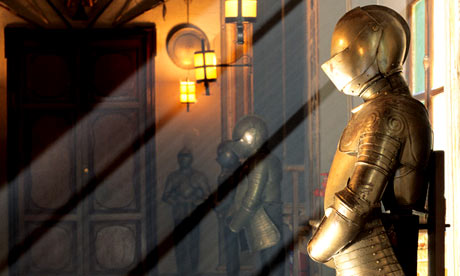
Men regularly wore metal in the 15th century, when oil painting first came into its own, and some of the greatest European painters were fascinated by the strange sartorial splendour of the battlefield and tournament.
Piero della Francesca's Brera altarpiece includes a portrait of the man who commissioned it, the cultured mercenary Federico da Montefeltro, kneeling in full plate armour that is as clearly reflective as a mirror. He looks as if he were wearing glass – the polished metal suggests his purity, his piety. Federico's reflective shine is that of a perfect knight. He looks like he could win the holy grail.
By contrast, in Giorgione's enigmatic painting of a young man in armour in the National Gallery of Scotland, the metal glints darkly, its burnished shadows sinister. A similar effect is used by Titian to convey both masculine power and inner anxiety in his portrait of Francesco Maria della Rovere in the Uffizi. Here, Titian uses the hardness of the battle gear to mirror the soul.
You don't have to content yourself with looking at paintings of armour, of course; wonderful examples survive. There is a sumptuous display of it in the V&A's new Medieval and Renaissance galleries. Other great places include the Wallace Collection and Tower of London in the capital, the Royal Armouries in Leeds, and the majestic armour galleries at New York's Metropolitan Museum of Art.
War is hell. But armour can be heavenly.
Jonathan Jones
Aucun commentaire:
Enregistrer un commentaire